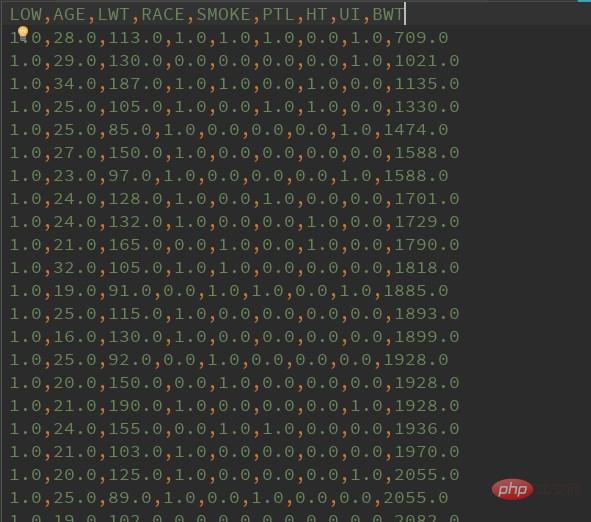Rumah >pembangunan bahagian belakang >Tutorial Python >python怎么读取csv文件
python怎么读取csv文件
- 步履不停asal
- 2019-07-03 09:40:545567semak imbas

Python读写csv文件
前言
逗号分隔值(Comma-Separated Values,CSV,有时也称为字符分隔值,因为分隔字符也可以不是逗号),其文件以纯文本形式存储表格数据(数字和文本)。纯文本意味着该文件是一个字符序列,不含必须像二进制数字那样被解读的数据。CSV文件由任意数目的记录组成,记录间以某种换行符分隔;每条记录由字段组成,字段间的分隔符是其它字符或字符串,最常见的是逗号或制表符。通常,所有记录都有完全相同的字段序列.
特点
读取出的数据一般为字符类型,如果是数字需要人为转换为数字
以行为单位读取数据
列之间以半角逗号或制表符为分隔,一般为半角逗号
一般为每行开头不空格,第一行是属性列,数据列之间以间隔符为间隔无空格,行之间无空行。
行之间无空行十分重要,如果有空行或者数据集中行末有空格,读取数据时一般会出错,引发[list index out of range]错误。PS:已经被这个错误坑过很多次!
使用python I/O写入和读取CSV文件
使用PythonI/O写入csv文件
以下是将"birthweight.dat"低出生体重的dat文件从作者源处下载下来,并且将其处理后保存到csv文件中的代码。
import csv
import os
import numpy as np
import random
import requests
# name of data file
# 数据集名称
birth_weight_file = 'birth_weight.csv'
# download data and create data file if file does not exist in current directory
# 如果当前文件夹下没有birth_weight.csv数据集则下载dat文件并生成csv文件
if not os.path.exists(birth_weight_file):
birthdata_url = 'https://github.com/nfmcclure/tensorflow_cookbook/raw/master/01_Introduction/07_Working_with_Data_Sources/birthweight_data/birthweight.dat'
birth_file = requests.get(birthdata_url)
birth_data = birth_file.text.split('\r\n')
# split分割函数,以一行作为分割函数,windows中换行符号为'\r\n',每一行后面都有一个'\r\n'符号。
birth_header = birth_data[0].split('\t')
# 每一列的标题,标在第一行,即是birth_data的第一个数据。并使用制表符作为划分。
birth_data = [[float(x) for x in y.split('\t') if len(x) >= 1] for y in birth_data[1:] if len(y) >= 1]
print(np.array(birth_data).shape)
# (189, 9)
# 此为list数据形式不是numpy数组不能使用np,shape函数,但是我们可以使用np.array函数将list对象转化为numpy数组后使用shape属性进行查看。
with open(birth_weight_file, "w", newline='') as f:
# with open(birth_weight_file, "w") as f:
writer = csv.writer(f)
writer.writerows([birth_header])
writer.writerows(birth_data)
f.close()
常见错误list index out of range
其中我们重点需要讲的是 with open(birth_weight_file, "w", newline='') as f: 这个语句。表示写入csv文件,如果不加上参数 newline='' 表示以空格作为换行符,而是用 with open(birth_weight_file, "w") as f: 语句。则生成的表格中会出现空行。

不仅仅是用python I/O进行csv数据的读写时,利用其余方法读写csv数据,或者从网上下载好csv数据集后都需要查看其每行后有没有空格,或者有没有多余的空行。避免不必要的错误~影响数据分析时的判断。
使用PythonI/O读取csv文件
使用python I/O方法进行读取时即是新建一个List 列表然后按照先行后列的顺序(类似C语言中的二维数组)将数据存进空的List对象中,如果需要将其转化为numpy 数组也可以使用np.array(List name)进行对象之间的转化。
birth_data = []
with open(birth_weight_file) as csvfile:
csv_reader = csv.reader(csvfile) # 使用csv.reader读取csvfile中的文件
birth_header = next(csv_reader) # 读取第一行每一列的标题
for row in csv_reader: # 将csv 文件中的数据保存到birth_data中
birth_data.append(row)
birth_data = [[float(x) for x in row] for row in birth_data] # 将数据从string形式转换为float形式
birth_data = np.array(birth_data) # 将list数组转化成array数组便于查看数据结构
birth_header = np.array(birth_header)
print(birth_data.shape) # 利用.shape查看结构。
print(birth_header.shape)
#
# (189, 9)
# (9,)使用Pandas读取CSV文件
import pandas as pd csv_data = pd.read_csv('birth_weight.csv') # 读取训练数据 print(csv_data.shape) # (189, 9) N = 5 csv_batch_data = csv_data.tail(N) # 取后5条数据 print(csv_batch_data.shape) # (5, 9) train_batch_data = csv_batch_data[list(range(3, 6))] # 取这20条数据的3到5列值(索引从0开始) print(train_batch_data) # RACE SMOKE PTL # 184 0.0 0.0 0.0 # 185 0.0 0.0 1.0 # 186 0.0 1.0 0.0 # 187 0.0 0.0 0.0 # 188 0.0 0.0 1.0
使用Tensorflow读取CSV文件
本人在平时一般都是使用Tensorflow处理各类数据,所以对于使用Tensorflow读取数据在此不过多的进行解释,下面贴上一段代码。
'''使用Tensorflow读取csv数据'''
filename = 'birth_weight.csv'
file_queue = tf.train.string_input_producer([filename]) # 设置文件名队列,这样做能够批量读取文件夹中的文件
reader = tf.TextLineReader(skip_header_lines=1) # 使用tensorflow文本行阅读器,并且设置忽略第一行
key, value = reader.read(file_queue)
defaults = [[0.], [0.], [0.], [0.], [0.], [0.], [0.], [0.], [0.]] # 设置列属性的数据格式
LOW, AGE, LWT, RACE, SMOKE, PTL, HT, UI, BWT = tf.decode_csv(value, defaults)
# 将读取的数据编码为我们设置的默认格式
vertor_example = tf.stack([AGE, LWT, RACE, SMOKE, PTL, HT, UI]) # 读取得到的中间7列属性为训练特征
vertor_label = tf.stack([BWT]) # 读取得到的BWT值表示训练标签
# 用于给取出的数据添加上batch_size维度,以批处理的方式读出数据。可以设置批处理数据大小,是否重复读取数据,容量大小,队列末尾大小,读取线程等属性。
example_batch, label_batch = tf.train.shuffle_batch([vertor_example, vertor_label], batch_size=10, capacity=100, min_after_dequeue=10)
# 初始化Session
with tf.Session() as sess:
coord = tf.train.Coordinator() # 线程管理器
threads = tf.train.start_queue_runners(coord=coord)
print(sess.run(tf.shape(example_batch))) # [10 7]
print(sess.run(tf.shape(label_batch))) # [10 1]
print(sess.run(example_batch)[3]) # [ 19. 91. 0. 1. 1. 0. 1.]
coord.request_stop()
coord.join(threads)
'''
对于使用所有Tensorflow的I/O操作来说开启和关闭线程管理器都是必要的操作
with tf.Session() as sess:
coord = tf.train.Coordinator() # 线程管理器
threads = tf.train.start_queue_runners(coord=coord)
# Your code here~
coord.request_stop()
coord.join(threads)
'''还有其他使用python读取文件的各种方法,这里介绍三种,不定期进行补充。
Atas ialah kandungan terperinci python怎么读取csv文件. Untuk maklumat lanjut, sila ikut artikel berkaitan lain di laman web China PHP!

